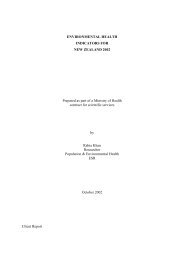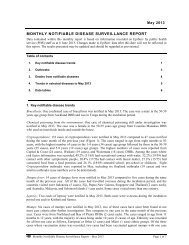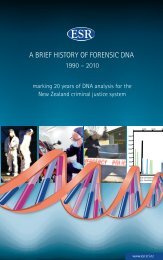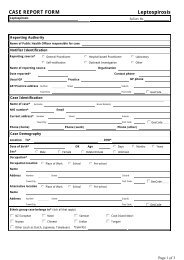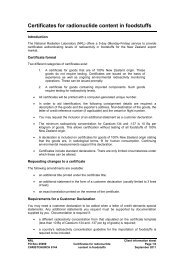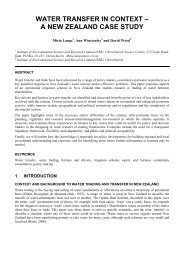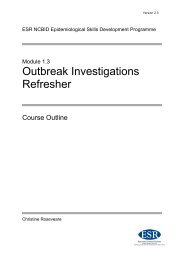Invasive Pneumococcal Disease in New Zealand, 2010
Invasive Pneumococcal Disease in New Zealand, 2010
Invasive Pneumococcal Disease in New Zealand, 2010
Create successful ePaper yourself
Turn your PDF publications into a flip-book with our unique Google optimized e-Paper software.
type most frequently reported to have <strong>in</strong>creased. 12,14 Increases <strong>in</strong> type 19A disease have beenof particular concern as this serotype is often associated with antibiotic resistance. 14,15 Therehave been recent reports of <strong>in</strong>creas<strong>in</strong>g rates of resistance among <strong>in</strong>vasive serotype 19Aisolates associated with shifts <strong>in</strong> the genetic structure of the isolates and the expansion ofparticular resistant clonal complexes. 16 As yet there have not been any significant <strong>in</strong>creases<strong>in</strong> rates of type 19A IPD <strong>in</strong> <strong>New</strong> <strong>Zealand</strong> s<strong>in</strong>ce the <strong>in</strong>troduction of PCV-7 but there was anon-significant <strong>in</strong>crease <strong>in</strong> the rate of 19A disease <strong>in</strong> those ≥65 years old between 2009 and<strong>2010</strong>: from 1.6 to 3.7 cases per 100 000. In addition, to date, <strong>in</strong>vasive serotype 19A isolates<strong>in</strong> this country are not especially associated with resistance and there have been no significantchanges <strong>in</strong> resistance among this type over the last 10 years.IPD cases due to the non-PCV-7 serotype 1 have <strong>in</strong>creased s<strong>in</strong>ce 2007, but appear to havepeaked <strong>in</strong> 2009 with the case numbers <strong>in</strong> <strong>2010</strong> (77) be<strong>in</strong>g less than half those <strong>in</strong> 2009 (153).These serotype 1 cases have been strongly associated with IPD <strong>in</strong> Māori and Pacific schoolagechildren and young adults. However, this <strong>in</strong>crease <strong>in</strong> serotype 1 disease is unlikely to bea result of serotype replacement follow<strong>in</strong>g the <strong>in</strong>troduction of PCV-7 s<strong>in</strong>ce the <strong>in</strong>crease <strong>in</strong>this type commenced before the <strong>in</strong>troduction of the vacc<strong>in</strong>e and appears to now be wan<strong>in</strong>g.In addition, it has ma<strong>in</strong>ly been associated with age-groups who are not eligible for PCV-7vacc<strong>in</strong>ation. This pattern of serotype 1 disease fits with that observed globally for thisserotype, that is, outbreaks that occurr<strong>in</strong>g cyclically every few years. 17<strong>Pneumococcal</strong> serotype 6C was first described <strong>in</strong> 2007. 18 Until <strong>2010</strong>, the serotyp<strong>in</strong>g methodsused at ESR resulted <strong>in</strong> both serotypes 6A and 6C be<strong>in</strong>g designated as type 6A.Retrospective work has commenced on re-typ<strong>in</strong>g <strong>in</strong>vasive pneumococcal isolates designatedas 6A prior to <strong>2010</strong> to differentiate types 6A and 6C. Correct categorisation of these isolateswill enable more precise monitor<strong>in</strong>g of any cross-serogroup protection conferred by theserotype 6B antigen <strong>in</strong>cluded <strong>in</strong> PCV-7 and PCV-10. The epidemiology of IPD <strong>in</strong> othercountries suggests that PCV-7 use has resulted <strong>in</strong> a reduction <strong>in</strong> type 6A, but not 6C, IPD. 19In <strong>2010</strong>, most (79.4%) of the IPD cases <strong>in</strong> <strong>in</strong>fants who had received ≥1 dose of PCV-7 weredue to a non-PCV-7 type. Among the seven cases who had received ≥1 dose of PCV-7 andhad disease due to a PCV-7 type, five had serotype 19F disease, one had type 6B disease andone had type 14 disease. Serotypes 19F and 6B were found to be the most common typesassociated with vacc<strong>in</strong>e breakthrough cases <strong>in</strong> a United States study. 20As most resistant <strong>in</strong>vasive pneumococci belong to one of the serotypes <strong>in</strong>cluded <strong>in</strong> PCV-7, adecrease <strong>in</strong> IPD caused by vacc<strong>in</strong>e types would be expected, and has been observed <strong>in</strong> othercountries, to have the concomitant effect of reduc<strong>in</strong>g the <strong>in</strong>cidence of IPD caused by resistantpneumococci. 21 Although there was a decrease <strong>in</strong> penicill<strong>in</strong> and cefotaxime resistancebetween 2008 and 2009, there was no further decrease between 2009 and <strong>2010</strong>. However,there is no <strong>in</strong>dication that resistance is <strong>in</strong>creas<strong>in</strong>g <strong>in</strong> non-PCV-7 serotypes <strong>in</strong> this country,with PCV-7 types still account<strong>in</strong>g for over 80% of the penicill<strong>in</strong> and cefotaxime resistance <strong>in</strong><strong>2010</strong>.We noted last year that nearly one-tenth (59/697) of the IPD cases notified <strong>in</strong> 2009 did not<strong>in</strong>clude evidence that they met the case def<strong>in</strong>ition. 7 This improved considerably <strong>in</strong> <strong>2010</strong> withno cases notified on the basis of pneumococci or pneumococcal DNA isolated from ordetected <strong>in</strong> a site that was unequivocally not a normally sterile site.<strong>Invasive</strong> pneumococcal disease 23 September 2011<strong>in</strong> NZ, <strong>2010</strong>




